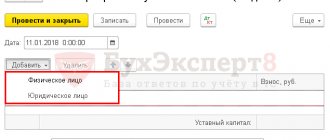The authorized capital of a joint stock company can be increased by increasing the par value of shares (clause 1 of Article 100 of the Civil Code of the Russian Federation, clause 1 of Article 28 of the Law of December 26, 1995 No. 208-FZ). Our article will tell you how to fill out a statement of changes in equity.
With this method of increasing the authorized capital, the organization issues (issues) new shares with a higher par value, the placement of which occurs through the conversion of previous shares (clause 17.1 of the regulation on standards of the Bank of Russia dated August 11, 2014 No. 428-P).
Sources of increasing authorized capital
An increase in the authorized capital by increasing the nominal value of shares can only be done at the expense of the organization’s property (paragraph 1, paragraph 5, article 28 of the Law of December 26, 1995 No. 208-FZ). That is, shareholders do not pay for an increase in the par value of shares.
The source of increasing the authorized capital in this case can be:
- additional capital of the company;
- balances of the company’s special purpose funds based on the results of the previous year (with the exception of the reserve fund and the corporatization fund for the organization’s employees);
- retained earnings from previous years.
This follows from clauses 16.2 and 19.2 of the regulation on standards of the Bank of Russia dated August 11, 2014 No. 428-P.
Features of increasing the authorized capital by issuing additional shares
Reduction and increase of the authorized capital of a joint-stock company is carried out in accordance with the norms of legislation - civil law and the Law “On Joint-Stock Companies”.
Regulatory documents set out two ways to increase capital:
- By issuing additional shares of the par value that is currently in effect.
- By increasing the par value of shares by exchanging shares of a smaller value for shares of a larger par value.
All issues regarding the increase and decrease of capital must be resolved at a general meeting of community members.
The method of increasing capital by issuing additional shares should not create a deformation of the authorized capital and shares of each participant. But there are exceptions to this rule - joint stock companies have the legal right to grant the benefit of common shares. Thus, community members who own common stock have greater rights to purchase additional shares than other members of the entity.
Features of this method of increasing capital:
- The decision regarding the increase can be made by the general meeting of founders or the board of directors.
- The number of additional shares is regulated by the framework stated in the constituent documentation of the joint-stock company. The Charter requires the following data: number, par value, types of shares. The decision to issue additional shares can be made by the board of shareholders, simultaneously with amendments to the Charter regarding the number of shares.
- The goals of increasing capital in this way are: attracting additional investments or bringing capital in line with the size of the legal entity’s property.
- It is necessary to accurately determine the number, par value, and methods of placement of additional shares.
The procedure, features and main problems of regulating the increase of capital by issuing additional shares are regulated by law.
Limits on the amount of increase
The amount by which the authorized capital is increased due to an increase in the par value of shares should not exceed the difference between the value of net assets and the sum of the authorized capital and the organization's reserve fund. For the calculation, data from financial statements (the deadline for submission of which has arrived) for the last quarter preceding the date of filing documents for state registration of the issue of shares are used. This follows from paragraph 19.2 of the regulation on standards of the Bank of Russia dated August 11, 2014 No. 428-P.
Example 1. Increasing the authorized capital due to the value of shares
The authorized capital of Omega CJSC was formed after the issue of 1000 shares. with a nominal value of 200 rubles. The meeting of shareholders in June decided to change the authorized capital of the company. To do this, they decided to increase the nominal value of the shares three times due to the profits remaining at the disposal of the organization based on the results of the previous year. In August, changes were made to the charter of Omega CJSC related to an increase in the authorized capital.
As a result of the conversion of shares with a par value of 200 rubles. in shares with a par value of 600 rubles. The authorized capital was increased by 400,000 rubles. (1000 pcs. (600 rub. – 200 rub.)). The following entries will be made in the accounting of Omega CJSC (Table 1).
| Contents of operation | Amount, rub. | Debit | Credit |
| 1. The increase in the par value of shares is reflected | 400 000 | 75 | 80.3 |
| 2. Retained earnings were used to increase the authorized capital | 400 000 | 84 | 75 |
Table 1 – Correspondence of accounts for increasing the authorized capital
When increasing the authorized capital at the expense of the joint-stock company’s own funds, shareholders must comply with the requirement established by Federal Law No. 208-FZ “On Joint-Stock Companies”. The amount by which the authorized capital is increased must not exceed the difference between the value of the net assets of the joint-stock company and the sum of the authorized capital and reserve fund. These indicators are calculated based on the issuer's financial statements for the last quarter (completed reporting period) preceding the date of submission of documents for state registration of the issue of shares.
Making and formalizing a decision
The decision to increase the authorized capital by increasing the nominal value of shares is made by:
- general meeting of shareholders (if the company has more than one shareholder). In this case, a majority of votes of shareholders - owners of voting shares of the company participating in the meeting - must be cast for the increase;
- sole founder (shareholder).
Formulate the decision to increase the authorized capital accordingly:
- minutes of the general meeting of shareholders;
- by decision of the sole founder (shareholder).
Such rules are established in paragraph 1 of Article 100 of the Civil Code of the Russian Federation, paragraph 2 of Article 28, paragraph 3 of Article 47, subparagraph 6 of paragraph 1 of Article 48, paragraph 2 of Article 49, Article 63 of the Law of December 26, 1995 No. 208-FZ.
When deciding to increase the authorized capital, determine:
- categories (types) of shares whose par value increases;
- par value of shares of each such category (type) after increase;
- method of placement of shares - conversion of shares into shares of the same category (type) with a higher par value;
- other conditions of conversion (for example, the date of conversion or the procedure for determining it, the property at the expense of which the authorized capital is increased).
This procedure follows from clause 17.1 of the regulation on standards of the Bank of Russia dated August 11, 2014 No. 428-P.
Decision to change the amount of the capital
The decision to increase the authorized capital of a joint-stock company is the prerogative of the meeting of owners. The articles of association may shift this responsibility to the board of directors. A resolution of the general meeting will be required if the increase in the volume of the charter capital is carried out through conversion. After the votes are counted, the decision is made by a majority.
Changing the volume of the capital may be the prerogative of the supervisory board and the meeting of co-owners if it is carried out by placing additional shares. The powers of the council must be confirmed by the charter.
Amendments to the charter
When increasing the authorized capital, changes must be made to the company's charter. The decision to make changes is made by:
- general meeting of shareholders (as a general rule);
- board of directors (supervisory board), if such powers are granted to it by the charter;
- sole founder (shareholder) (if the organization has only one founder (shareholder)).
In the first case, draw up the minutes of the general meeting of shareholders. The second contains the minutes of the meeting of the board of directors (supervisory board). In the third - the decision of the sole founder (shareholder).
This is stated in paragraph 2 of Article 12, paragraph 3 of Article 47, Article 63, paragraph 4 of Article 68 of the Law of December 26, 1995 No. 208-FZ.
If the decision to change the charter is made by the general meeting of shareholders, at least 3/4 of the votes of shareholders - owners of voting shares participating in the general meeting must be cast for the change (Clause 4 of Article 49 of the Law of December 26, 1995 No. 208-FZ ). When this decision is made by the board of directors, a majority vote of its members is sufficient, unless the company’s charter establishes other rules (clause 3 of article 68 of the Law of December 26, 1995 No. 208-FZ).
Registration with the tax office
Changes made to the charter must be registered with the tax office (Article 13, paragraph 1 of Article 14 of the Law of December 26, 1995 No. 208-FZ, Article 17 of the Law of August 8, 2001 No. 129-FZ).
In addition, the issue of new shares with a higher par value and a report on the results of the issue of securities are subject to state registration. The procedure for state registration of changes in the charter, the issue of new shares with a higher par value and the report on the results of the issue of securities is similar to the procedure that is applied when registering an additional issue of shares (clauses 3.3, 5.1–5.7, 8.1–8.3, 18.1 of the regulations on the standards of the Bank of Russia dated August 11, 2014 No. 428-P).
Accounting
In accounting, reflect the increase in the size of the authorized capital as of the date of state registration of the changes made to the charter. This is due to the fact that the amount of the authorized capital reflected in the accounting must correspond to its size recorded in the constituent documents of the organization (letter of the Ministry of Finance of Russia dated March 21, 2007 No. 07-05-12/03).
As of the date of the decision to increase the par value of the shares, no accounting entries need to be made.
Reflect the increase in the authorized capital due to an increase in the par value of shares with the following entries:
Debit 83 Credit 80
– reflects the increase in the authorized capital at the expense of the organization’s additional capital;
Debit 84 Credit 80
– reflects the increase in the authorized capital at the expense of retained earnings from previous years.
Include the state duty for registration of changes in the charter, issue of shares and report on the results of the issue of securities as other expenses (clause 11 of PBU 10/99). For the amount of state duty paid, make the following entries in your accounting:
Debit 68 subaccount “State duty” Credit 51
– state duty is transferred to the budget;
Debit 91-2 Credit 68 subaccount “State duty”
– the cost of state duty is included in other expenses.
The procedure for accounting for an increase in the authorized capital due to an increase in the par value of shares when calculating taxes depends on what taxation system the organization uses.
An example of increasing the authorized capital of an organization by increasing the par value of shares. The conversion was made using additional capital funds
The authorized capital of JSC "Proizvodstvennaya" is 4,000,000 rubles. (2000 shares with a par value of 2000 rubles). The value of the organization's net assets is 18,000,000 rubles. The size of the organization’s additional capital is 15,000,000 rubles, and the reserve fund is 200,000 rubles.
In July, the general meeting of Master shareholders decided to increase the authorized capital using the organization’s additional capital by increasing the par value of shares by 2,000,000 rubles.
The maximum amount by which the authorized capital of the company can be increased is 13,800,000 rubles. (RUB 18,000,000 – (RUB 4,000,000 + RUB 200,000)).
The amount by which it is decided to increase the authorized capital of the organization does not exceed this value. Therefore, the authorized capital was increased by 2,000,000 rubles.
As a result, the par value of each share increased by 1,000 rubles. (RUB 2,000,000: 2000 pcs.).
One of the organization’s shareholders is an individual – A.V. Lvov (he is also the general director of the organization). He owns 500 shares.
After increasing the authorized capital, the par value of each share in Lvov increased by 1,000 rubles. and amounted to 3000 rubles. (2000 rub. + 1000 rub.). The nominal value of all Lvov shares eventually increased by 500,000 rubles. (500 pcs. × 1000 rub.). The Master's accountant must withhold personal income tax from this amount.
In August, Lvov’s salary was accrued. Lviv does not have the right to standard tax deductions. Personal income tax on the amount of increase in the nominal value of Lvov shares in the authorized capital of the company is withheld on a general basis.
The increase in the authorized capital and the issue of shares were registered in August.
The organization paid the state fee:
- 20,000 rub. – for registration of the issue of shares and a report on the results of the issue;
- 800 rub. – for registration of changes in the charter.
Alpha's accountant made the following entries in the accounting.
On the date of payment of the state duty for registration of the issue of shares and the report on the results of the issue:
Debit 68 subaccount “State duty” Credit 51 – 20,000 rub. – state duty has been paid to the budget.
As of the date of receipt of the notice of state registration of the issue of shares and the report on the results of the issue:
Debit 91-2 Credit 68 subaccount “State duty” - 20,000 rubles. – the cost of state duty is included in other expenses.
As of the date of payment of the state fee for registration of changes in the charter:
Debit 68 subaccount “State duty” Credit 51 – 800 rub. – state duty has been paid to the budget.
As of the date of receipt of the certificate of state registration of changes in the charter:
Debit 91-2 Credit 68 subaccount “State duty” - 800 rubles. – the cost of state duty is included in other expenses;
Debit 83 Credit 80 – 2,000,000 rub. – reflects the increase in the authorized capital at the expense of the organization’s additional capital.
The accountant withheld personal income tax from the amount of increase in the nominal value of Lvov shares at the time of payment of salaries for August:
Debit 70 Credit 68 subaccount “Personal Income Tax Payments” – 65,000 rubles. (RUB 500,000 × 13%) – personal income tax withheld.
By conversion (change in par value of shares)
This method increases capital through various “assets”, i.e. at the expense of the Company's property.
Important: the amount of increase in the capital capital cannot be higher than the difference between the value of the Company’s net assets and the size of the capital capital and the company’s reserve fund.
In this case, the key point is given to the work of the accounting department, which transfers assets into liabilities (AC). Conversion is relevant to achieve a specific amount of capital required to obtain licenses, developer status, etc.
Personal income tax and insurance premiums
As a result of increasing the authorized capital of the organization, the nominal value of the shares will also increase.
Personal income tax must be withheld from the amount of the difference between the original and new par value of shares of individuals. This procedure follows from paragraph 1, paragraph 3 of paragraph 5 of Article 28 of the Law of December 26, 1995 No. 208-FZ and is confirmed in letters of the Ministry of Finance of Russia dated May 21, 2014 No. 03-04-05/24185 and dated January 12, 2006 No. 03-05-01-04/2.
An exception will be the case when the increase in the authorized capital occurs due to the revaluation of fixed assets. There is no need to withhold personal income tax from such shareholder income (Clause 19, Article 217 of the Tax Code of the Russian Federation).
When the nominal value changes, the following is not charged:
- contributions for compulsory pension, social and health insurance (Part 1, Article 7 of Law No. 212-FZ of July 24, 2009);
- contributions for insurance against accidents and occupational diseases (clause 1 of article 20.1 of the Law of July 24, 1998 No. 125-FZ).
This is due to the fact that such payments do not relate to remuneration received for the performance of duties under employment and civil law contracts.
Use of additional capital funds
Additional capital funds are most often used for:
- repayment of amounts reduced in the value of fixed assets as a result of revaluation;
- an increase in retained earnings when writing off fixed assets that were subject to revaluation;
- increase in the authorized capital of the organization.
Use of additional capital as a result of revaluation of fixed assets
During revaluation, you can reduce the value of those fixed assets that were previously overvalued. The amount of the markdown equal to the amount of the previous revaluation, which was included in the additional capital, reduces the additional capital.
The excess of the depreciation amount over the amount of such revaluation is debited to account 91 “Other income” (referred to the financial result).
Use of additional capital when writing off fixed assets subject to revaluation
If an item of fixed assets is disposed of, the value of which was increased as a result of revaluation, then the amount of its revaluation, listed in account 83 “Additional capital”, must be included in retained earnings:
Debit 83 Credit 84
– the amount of revaluation of the disposed fixed asset item is included in retained earnings.
Use of additional capital to increase the authorized capital of the organization
If the additional capital funds were used to increase the authorized capital of the organization, it is necessary to register the corresponding changes in the constituent documents, and make the following entry in accounting:
Debit 83 Credit 80 – reflects the increase in the authorized capital.
Income tax
An increase in the par value of shares does not affect the calculation of income tax. The difference between the par value of new shares received in exchange for the original ones is not taken into account when calculating income tax (Clause 31, Article 270 of the Tax Code of the Russian Federation).
If such a difference has arisen for a shareholder - a foreign organization that does not operate in Russia through a permanent establishment, there is no need to withhold income tax from it. In this case, the company is not a tax agent in relation to its shareholder - a foreign organization. Since such amounts are excluded from the taxable income of shareholder organizations (subclause 15, clause 1, article 251 of the Tax Code of the Russian Federation).
The amount of state duty paid for registration of the issue of shares, a report on the results of the issue and amendments to the charter can be attributed to:
- for other expenses (subclause 1, clause 1, article 264 of the Tax Code of the Russian Federation, letter of the Federal Tax Service of Russia for Moscow dated June 26, 2006 No. 20-12/56686);
- for non-operating expenses - as costs associated with the issue of shares (subclause 3, clause 1, article 265 of the Tax Code of the Russian Federation).
The organization has the right to independently decide which expenses include the amount of state duty (clause 4 of Article 252 of the Tax Code of the Russian Federation).
When using the accrual method, take into account the amount of the state duty at the time of its accrual (subclause 1, clause 7, article 272 of the Tax Code of the Russian Federation). With the cash method - as it is paid to the budget (subclause 3, clause 3, article 273 of the Tax Code of the Russian Federation).
simplified tax system
Regardless of the chosen object of taxation, organizations applying the simplification do not take into account the difference between the par value of new shares received in exchange for the original ones when calculating the single tax (clause 1 of Article 346.16 of the Tax Code of the Russian Federation).
Organizations that pay a single tax on the difference between income and expenses, the amount of state duty paid for registering the issue of shares, a report on the results of the issue and making changes to the charter, can be included in expenses (subclause 22, clause 1, article 346.16 of the Tax Code of the Russian Federation). This must be done at the time of payment to the budget (clause 2 of Article 346.17 of the Tax Code of the Russian Federation).
Combination of OSNO and UTII
Since the payment of the state duty paid for registering the issue of shares, a report on the results of the issue and making changes to the charter is simultaneously related to the organization’s activities on the general taxation system and to activities subject to UTII, the amount of the fee must be distributed (clause 9 of article 274, clause 7 Article 346.26 of the Tax Code of the Russian Federation). For more information about this, see How to take into account expenses for income tax when combining OSNO with UTII.
Income tax expenses include only the amount of state duty related to the organization’s activities on the general taxation system (subclause 1, clause 1, article 264, subclause 3, clause 1, article 265 of the Tax Code of the Russian Federation).







